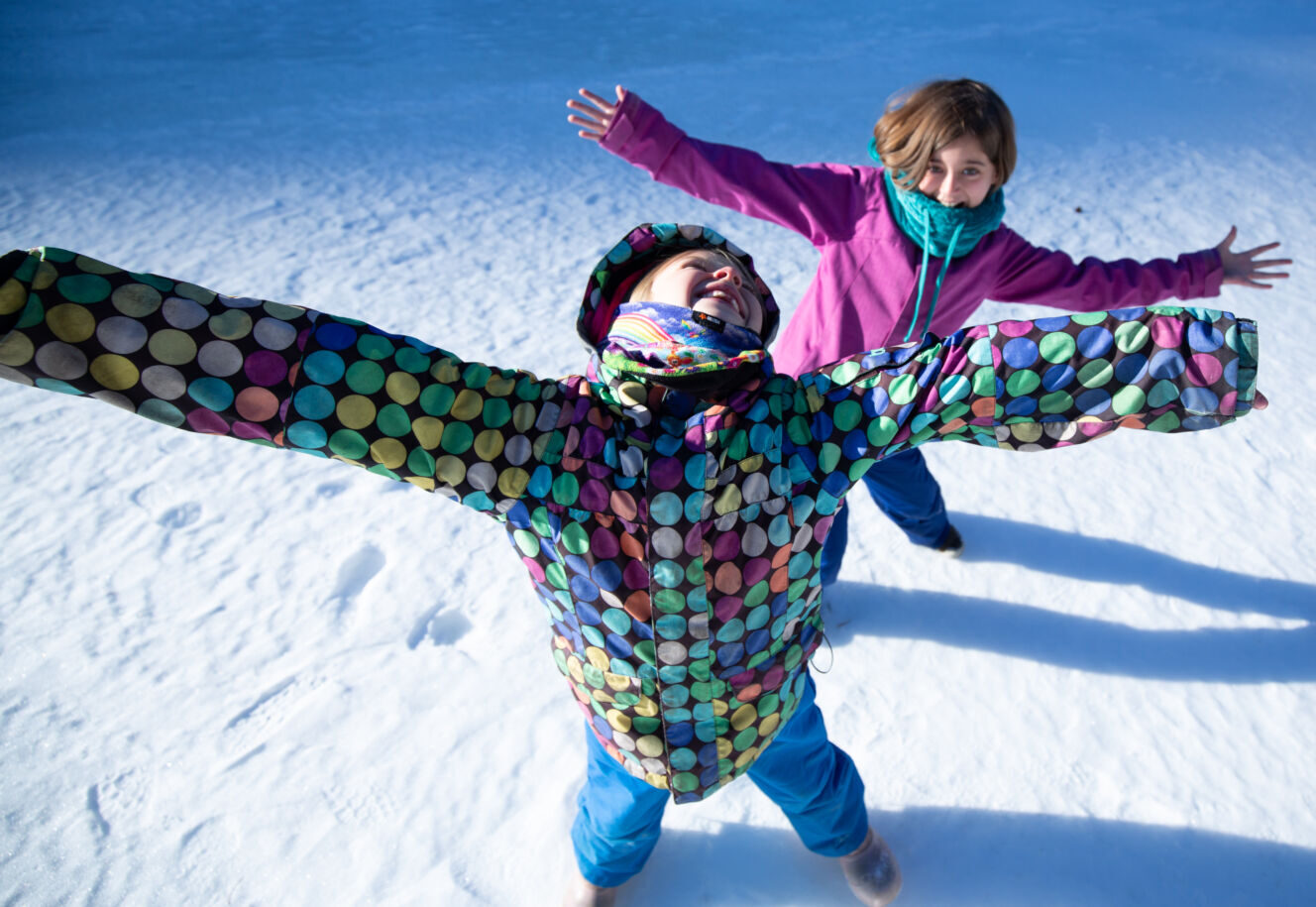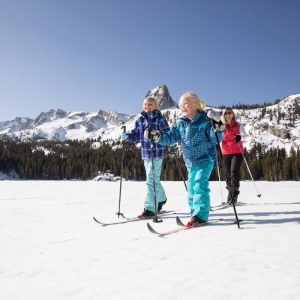Winter in Mammoth Lakes offers a wide range of outdoor activities and dressing appropriately will make these snow-filled fun adventures all the more enjoyable.
Layers are key to staying warm and comfortable. Temperatures can fluctuate by as much as 30 degrees or more on the snow. You’ll stay warm when you are active, but sitting still on a chairlift will cool you off. Here is a brief guide on how to dress in layers, to enjoy every minute of your time in the mountains.

Knowing how to dress in layers starts with understanding the purpose of each layer. For the most part, you will want to create 3-4 basic layers depending on the temperature. These include:
- A thin base layer in a fabric that helps wick moisture (perspiration) from your skin
- Optional: a second lighter or heavier weight base layer
- A middle layer made of materials made to retain body heat, which will protect you from the cold
- An outer or shell layer that shields you from wind, rain, or moisture from snow
1. Base Layer
In cold conditions, it is particularly important to keep moisture away from your skin to maintain body heat. You want to choose a base layer top and bottom (and possibly undergarments) made of synthetic fabrics that specifically wick moisture. There are natural options like wool and silk; however, they tend to be more bulky, less comfortable and not work as well as synthetic options. Cotton is not a good option, because is keep the moisture your body produces next to your skin. If you haven’t been in the cold for a while, this layer used to be called long johns and the fabric used was a cotton/synthetic blend. The knowledge and technology has improved over the years to provide warmer and dryer options.
Base layers come in a number of different weights, generally ranging from lightweight to heavyweight, although you may find options like “ultra-lightweight” or “expedition weight.” Keep in mind, pairing different weights provides you the flexibility to remove and add layers when the temperatures fluctuate.
Focusing on the pants, if you have insulated pants, you’ll likely just stick with a midweight base layer and the pants. If you have shell pants, you can choose a much heavier base layer. When you are trying clothes on at a shop, you will quickly identify your preference.
2. Optional: Light Insulating Layer
For colder winter days and spring days with a large temperature fluctuation, you may opt for an additional layer that can be stowed away as temperatures rise and cool. This layer can be another wicking base layer of a different weight or even a long sleeve shirt.
3. Middle Insulating Layer
One of your layers needs to be an insulating layer. If you aren’t wearing an insulated jacket for your outer layer, then you want a warm fleece or down jacket for your middle insulating layer. If the temperatures are moderately cold, this may be a fleece or down vest.
4. Shell or Insulated Jacket and Pants?
Insulated
You can choose an insulated jacket/pants or a shell for your outer layers. Or mix and match. The purpose of this outer layer is to protect you from the wet snow to keep you dry and you want to pay attention to its waterproof/water resistant rating. Insulated jacket and pants is nice for cold days, but you may overheat with just the one option when the weather is more moderate.
Shell
The benefit of a shell is that you can control how hot you are by adding or removing layers. Because the shell only provides weatherproofing, and not insulation, it may have more uses outside of skiing and snowboarding. The drawback of a shell is dealing with the extra layers. Again, you’ll quickly find your preference while trying these clothes on at a shop and with experience.
Also look for features like pit zips that can help you dump heat in both your jacket and pants.
The Rest Of What You Need
- Ski and snowboard socks – 100% synthetic and try not to buy bulky socks. If your feet are getting cold, test to see if your boots are on too tight. Sometimes circulation is the problem.
- Gloves, Goggles & Boots – just our personal opinion but as avid outdoor enthusiasts, gloves, goggles, and boots are where you really get what you pay for. If your hands are always cold, consider mittens – either down or synthetic. Sorrels are a mountain favorite for boots to wear off-the-mountain and in other winter activities
- Helmet and hats – wearing a hat in the cold and a helmet on the mountain will keep you exponentially warmer. Add goggles and a neck gaiter and you’ll be all sealed up from the wind and the elements.
Book Your Trip
We covered a lot, but rest assured we have experts galore that can help! Mammoth Lakes is home to many award-winning ski and snowboard shops. They are more than happy to help you with your personalized shopping needs.
Now it’s time to book your stay! If you have any other questions about your trip, please don’t hesitate to ask us. We’re happy to help! Just call us at +1 (800) 421-1849 or email info@1849MountainRentals.com.
More Trip Tips
- 1849 Mountain Rentals’ Unique Guest AmenitiesPhoto above: Recreation Area at 1849 Condos Stay closer…and enjoy elevated amenities 1849 Mountain Rentals has built its reputation on its slopeside convenience and guest services. Every slopeside spacious home… Read more: 1849 Mountain Rentals’ Unique Guest Amenities
- 5 Benefits of Direct Booking with 1849 Mountain RentalsThe only thing better than a vacation is saving money on vacation. And if you have already been researching how to save on your next getaway, you’ve probably come across… Read more: 5 Benefits of Direct Booking with 1849 Mountain Rentals
- 5 Family-Friendly Mammoth Lakes Winter ActivitiesMammoth Mountain is known as one of the nation’s most impressive and epic ski destinations. The slopes are numerous, challenging, and gorgeous, offering breathtaking views as visitors glide along snowy… Read more: 5 Family-Friendly Mammoth Lakes Winter Activities





